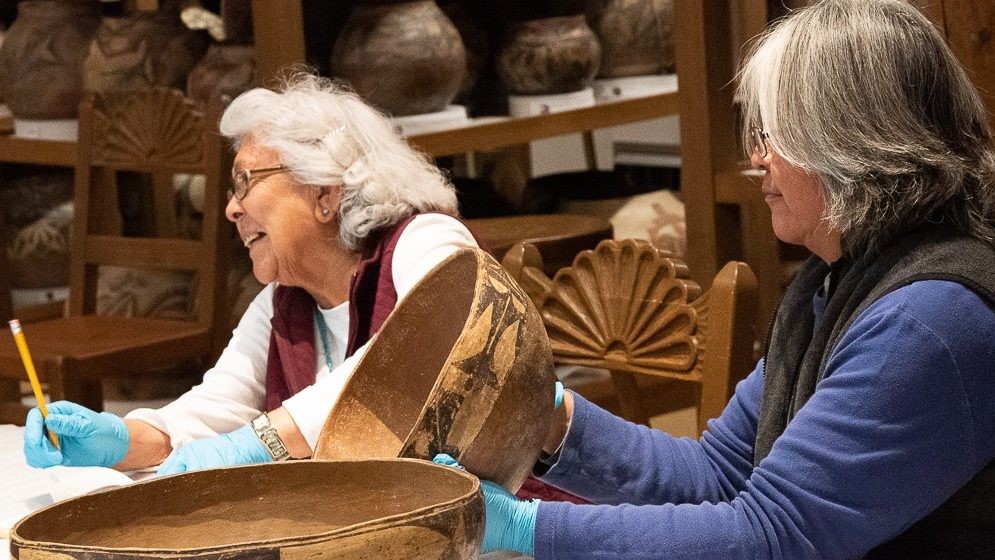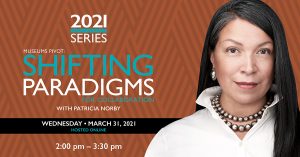Dolores Lewis Garcia and Claudia Mitchell during a collections review at the Indian Arts Research Center.
Guest post by Emily Santhanam, 2020–2021 SAR Anne Ray Intern
Museums are evolving. In a cultural moment in which institutions are called toward self-reflection, inclusivity, and accountability, the question remains: What does collaboration mean for museum and community, institution and individual? How can ethical action drive our work?
Enter SAR’s Guidelines for Collaboration. Originally published in 2016, and revised in 2019, the Guidelines offer principles and considerations for building successful collaborations between institutions with collections and Native American communities. Composed of two separate but complementary sets of guidelines—one for museums, one for communities—these documents provide questions, suggestions, and food for thought.
Fittingly, the Guidelines developed after years of hearty conversations. Landis Smith has worked as a conservator for decades, assisting museums in carrying out collaborative methodologies. Seeing the need for a more robust dialogue on the topic in 2012, she reached out to Cynthia Chavez Lamar, former director of SAR’s Indian Arts Research Center, current director of the National Museum of the American Indian, and the first Indigenous woman to lead a Smithsonian museum—a major achievement in the field.
When asked why she wanted to partner with SAR, Smith said, “I went to Cynthia [Chavez Lamar] because the School [for Advanced Research] is known for bringing key people together and seeing where the discussion leads.” And that’s exactly what happened. Facilitated by Lamar and Smith under a grant from the Anne Ray Foundation, the initial seminar on collaborative approaches brought together conservators, collections managers, curators, tribal museum directors, artists, and cultural leaders from North America and New Zealand.
But the conversation didn’t end there. A core group of tribal and non-tribal museum professionals met periodically to dive deeper into the topic, ultimately developing the Guidelines for Collaboration. Successive IARC directors Brian Vallo (now governor of Acoma Pueblo) and Elysia Poon have continued to support and extend the reach of the Guidelines, with Smith serving in the keystone capacity of co-facilitator and organizer.
Despite being created by a cohort of esteemed museum professionals, the Guidelines are approachable. The “Guidelines for Museums,” for example, begin with a basic definition of what collaboration is and isn’t:
True collaboration does not happen immediately—it is process driven and takes time and commitment. The specific manner in which you collaborate will be unique to your museum, the community, and the project. Do not confuse collaboration with a single invitation to view or comment on collections, or to rubber-stamp exhibition content.
This foundational definition is key. Too often, institutions see the act of reaching out to Native communities as ticking their inclusivity box. The actual work of learning what the community members want, of listening to and taking seriously their knowledge and expertise, is an afterthought. Having worked at the IARC as a 2020–2021 Anne Ray intern, I was able to see firsthand what the enaction of the Guidelines looked like. It was about prioritizing the community, from their preferences in the collections (wearing gloves or using bare hands to handle works), to the museum database (what language, terms, and information were shared), to the terms for future interactions.
With their how-to structure, the Guidelines have been widely influential. The Field Museum, University of California–Los Angeles in collaboration with the Getty Conservation Institute, University of Colorado–Boulder, Rhode Island School of Design, and even the Metropolitan Museum of Art (Met) have incorporated aspects of the Guidelines into their policies. Dr. Patricia Norby (Purépecha), the Met’s first Indigenous curator and first full-time curator of Native American Art, was a keynote speaker at SAR’s IARC Speaker Series in 2021. Among other subjects, she touched on the work being undertaken at the Met to update collections records and exhibition labels for Indigenous objects:
We’re making a lot of changes to our databases so they’re reflected online, we’re changing labels regarding sensitive language, and [we’re] presenting the work from an Indigenous voice, not from this curatorial, “expert” voice. It’s important work, but it takes time—and it takes many conversations with my colleagues and community members.
Norby shows how collaboration can help improve museum information. The Guidelines themselves include specific case studies of successful collaborations within a range of topics, including cultural revitalization, artistic inspiration and arts revitalization, culturally appropriate care, collaborative conservation, and new technologies. I was surprised to see my own tribe, the Chickasaw Nation, named in the Guidelines for having sought and incorporated advice from our Council of Elders in discussions on artifact replicas. Not every museum gets it right all the time, and even tribal museums and cultural centers can benefit from the tenets outlined in the Guidelines.
Having witnessed the need for and adoption of the Guidelines, Poon and Smith aren’t slowing down anytime soon. They’re currently developing a set of guidelines for the American Alliance of Museums (AAM) under the facilitation of former SAR Anne Ray scholar Deana Dartt. These guidelines, called the Core Standards for Museums with Native American Collections, take a more philosophical approach and expand toward other forms of museum work, like strategic planning, organizational structure, and human resources. In speaking of this project, Poon reiterates,
The work that we do is really focused on creating more equity between museums and the communities that they work with. This needs to happen at a variety of levels: not just boots on the ground, person-to-person interactions, but also at a higher level, a policy level. Support of the guidelines and other policy-oriented documents is really important.
With the Core Standards set to debut in a couple years, Poon and Smith are looking forward to seeing more institutional change in museums. They’re optimistic about the next generation of museum professionals using these resources to push for even more positive museum-to-community relationships. “I think what’s really gratifying,” Poon says, “particularly with the use of the Guidelines in classrooms, is that it allows students to take the tenets of the Guidelines and really think about how to take things to the next step. . . . It’s helping to encourage the next generation of museum professionals to work even better with communities.”
And this, at the end of the day, is what centers the Guidelines and Core Standards: They’re meant to shift and respond to the needs of museums and communities, across time and place. The Guidelines are a meaningful contribution to collaboration writ large—and the conversation’s still unfolding.

